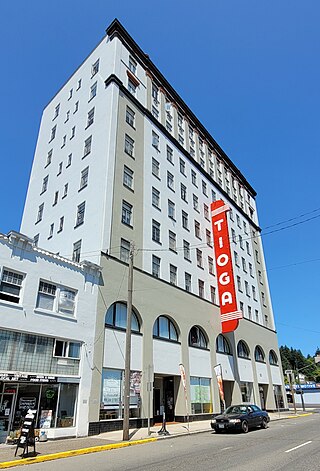
Coos Bay is a city located in Coos County, Oregon, United States, where the Coos River enters Coos Bay on the Pacific Ocean. The city borders the city of North Bend, and together they are often referred to as one entity called either Coos Bay-North Bend or Oregon's Bay Area. Coos Bay's population as of the 2020 census was 15,985 residents, making it the most populous city on the Oregon Coast. Oregon's Bay Area is estimated to be home to 32,308.

USS Coos Bay (AVP-25) was a United States Navy Barnegat-class small seaplane tender in commission from 1943 to 1946 that saw service during the latter half of World War II. After the war, she was in commission in the United States Coast Guard from 1949 to 1966 as the cutter USCGC Coos Bay (WAVP-376), later WHEC-376.

The history of steamboats on the Oregon Coast begins in the late 19th century. Before the development of modern road and rail networks, transportation on the coast of Oregon was largely water-borne. This article focuses on inland steamboats and similar craft operating in, from south to north on the coast: Rogue River, Coquille River, Coos Bay, Umpqua River, Siuslaw Bay, Yaquina Bay, Siletz River, and Tillamook Bay. The boats were all very small, nothing like the big sternwheelers and propeller boats that ran on the Columbia River or Puget Sound. There were many of them, however, and they came to be known as the "mosquito fleet."

The Coquille River starts in the Siskiyou National Forest and flows hundreds of miles through the Coquille Valley on its way to the Pacific Ocean. Bandon, Oregon, sits at the mouth of the Coquille River on the Pacific Ocean. Before the era of railroads and later, automobiles, the steamboats on the Coquille River were the major mode of transportation from Bandon to Coquille and Myrtle Point in southern Coos County, Oregon, United States.

The Coos Bay Mosquito Fleet comprised numerous small steamboats and motor vessels which operated in the late 19th and early 20th centuries on Coos Bay, a large and mostly shallow harbor on the southwest coast of the U.S. state of Oregon, to the north of the Coquille River valley. Coos Bay is the major harbor on the west coast of the United States between San Francisco and the mouth of the Columbia River.

Carlos A. Gothong Lines, popularly known as CAGLI and formerly once known as simply Gothong Lines, is a passenger and cargo ferry company based in Cebu, Philippines. CAGLI was formerly a part of WG&A SuperFerry, a company in January 1996 which served 23 major provincial ports throughout the Philippines and was the first domestic shipping company in the country to be certified by the International Safety Management Code standard. CAGLI, William Lines and Aboitiz Shipping formed was the biggest merger in the Philippine shipping industry.
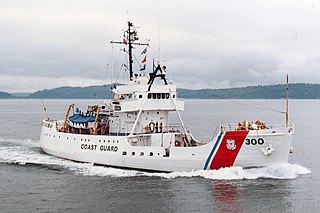
USCGC Citrus (WAGL-300/WLB-300/WMEC-300) was a Cactus (A)-class seagoing buoy tender built in 1942 in Duluth, Minnesota, and now operated by the navy of the Dominican Republic.
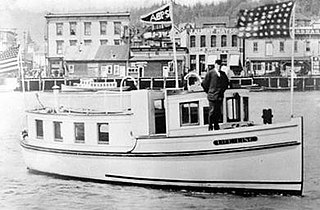
Life-Line was a Baptist missionary boat used to conduct ministry work in the Coos Bay region of southwestern Oregon, United States, from 1914 to 1923.
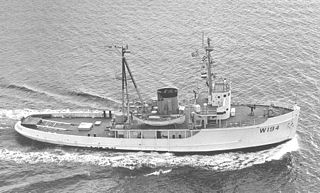
The auxiliary ocean tug USS ATA-194 was laid down on 7 November 1944 at Orange, Texas, by the Levingston Ship Building Co.; launched 4 December 1944; and commissioned at Orange on 14 February 1945.

Rainbow was a sternwheel steamboat that was operated in the Coos Bay region of Oregon from 1912 to 1923. Rainbow is sometimes referred to as a "launch", meaning a small steamboat. This vessel's name is sometimes seen as Rain-Bow.

Myrtle was a steamboat built in 1909 for service on the Coquille River and its tributaries, in Oregon. The ability of this small vessel to reach remote locations on the river system was cited many years later as evidence in support of the important legal concept of navigability.

Liberty was a sternwheel steamboat that was operated on the Coquille River and then on Coos Bay from 1903 to 1918. Liberty was notable for having its ownership entangled in various legal claims in the early 1910s, including some involving a colorful North Bend, Oregon business promoter Lorenzo Dow "Major" Kinney (1855-1920).

Dispatch was a sternwheel steamboat that was operated on the Coquille River on the southern Oregon coast from 1903 to 1920. The name of this vessel is sometimes seen spelled Despatch. This sternwheeler should not be confused with an earlier and somewhat smaller sternwheeler, also named Dispatch, that was built at Bandon, Oregon, in 1890, for which the 1903 Dispatch was a replacement.

Eva was a sternwheel steamboat that was operated on the Umpqua River on the Oregon coast in the early part of the 1900s. Eva was notable for long service on a short route of about 20 miles. Eva was also notable for having been used by one of its owners to illegally transport dynamite on a passenger-carrying vessel, by the ruse of labeling the dynamite boxes as "bacon."
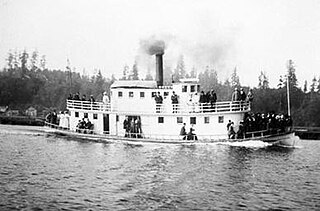
Favorite was a small steamboat that was operated on the Coquille River, Coos Bay and on the Siuslaw River, in the southern Oregon coast region from 1900 to 1918.

Wolverine was a launch powered by a gasoline engine that operated on the Coquille River on the southern coast of Oregon, United States, from 1908 to the 1920s. Later the boat operated on Coos Bay, and, in the mid-1930s, was transferred to Eureka, California. Wolverine is principally known for its early service as a high-speed passenger vessel.

Montesano was a steamboat that was operated from 1882 to about 1903 in the coastal regions of Oregon and southwest Washington, including Astoria, Willapa Bay, Grays Harbor, the Chehalis River, Yaquina Bay and Coos Bay. The Montesano of 1882, built in Astoria, should not be confused with another, larger sternwheeler, also named Montesano, built-in Cosmopolis, Washington, in 1889.
The SS Lewis Emery Jr. was a World War II liberty ship built by the Alabama Drydock and Shipbuilding Company at their yard at Mobile, Alabama, and launched on 15 October 1943.
















